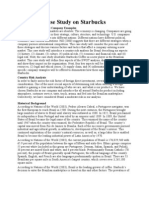Brazil
Uploaded by
Eduard NicolaeBrazil
Uploaded by
Eduard NicolaeIt
Brazil, officially the Federative Republic of Brazil is the largest country in South America. is the world's fifth largest country, both by geographical area and by population with over 192 million people. It is the only Portuguese-speaking country in the Americas and the largest lusophone country in the world.
The natural heritage of Brazil is severely threatened by cattle ranching and agriculture, logging, mining, resettlement, oil and gas extraction, over-fishing, wildlife trade, dams and infrastructure, water contamination, climate change, fire, and invasive species. In many areas of the country, the natural environment is threatened by development. Construction of highways has opened up previously remote areas for agriculture and settlement; dams have flooded valleys and inundated wildlife habitats; and mines have scarred and polluted the landscape. At least 70 dams are said to be planned for the Amazon region, including controversial Belo Monte hydroelectric dam. Brazil's population increased significantly between 1940 and 1970, due to a decline in the mortality rate, even though the birth rate underwent a slight decline. In the 1940s the annual population growth rate was 2.4%, rising to 3.0% in the 1950s and remaining at 2.9% in the 1960s, as life expectancy rose from 44 to 54 years and to 72.6 years in 2007. It has been steadily falling since the 1960s, from 3.04% per year between 19501960 to 1.05% in 2008 and is expected to fall to a negative value of 0.29% by 2050 thus completing the demographic transition. Roman Catholicism is the country's predominant faith. Brazil has the world's largest Catholic population.According to the 2000 Demographic Census (the PNAD survey does not inquire about religion), 73.57% of the population followed Roman Catholicism; 15.41% Protestantism; 1.33% Kardecist spiritism; 1.22% other Christian denominations; 0.31% Afro-Brazilian religions; 0.13% Buddhism; 0.05% Judaism; 0.02% Islam; 0.01% Amerindian religions; 0.59% other religions, undeclared or undetermined; while 7.35% have no religion. The official language of Brazil is Portuguese, which almost all of the population speaks and is virtually the only language used in newspapers, radio, television, and for business and administrative purposes The core culture of Brazil is derived from Portuguese culture, because of its strong colonial ties with the Portuguese empire. Among other influences, the Portuguese introduced the Portuguese language, Roman Catholicism and colonial architectural styles. The culture was, however, also strongly influenced by African, indigenous and non-Portuguese European cultures and traditions. Some aspects of Brazilian culture were influenced by the contributions of Italian, German and other European immigrants who arrived in large numbers in the South and Southeast of Brazil. Brazilian cuisine varies greatly by region, reflecting the country's mix of native and immigrant populations. This has created a national cuisine marked by the preservation of regional differences. Examples are Feijoada, considered the country's national dish; and regional foods such as vatap, moqueca, polenta and acaraj. The Carnival in Rio de Janeiro is a world famous festival held before Lent every year and considered the biggest carnival in the world with two million people per day on the streets. The first festivals of Rio date back to 1723. The purpose of carnival is for samba schools to compete with fellow rival schools; this competition is the climax of the whole carnival festival. Each school chooses a theme to try and portray in their entry. The samba schools work to build the best floats and costumes to represent their themes, and to include the best music they can from their band called the bateria. Nicol ae Eduard I A.M. - B
You might also like
- Isra El Bust Os, Maf Er Sarr E, Fran Cisc oNo ratings yetIsra El Bust Os, Maf Er Sarr E, Fran Cisc o19 pages
- Universidad Tecnologica de Los Andes: Facultad de Ciencias Juridicas, Contables Y Sociales Escuela Profesional de DerechoNo ratings yetUniversidad Tecnologica de Los Andes: Facultad de Ciencias Juridicas, Contables Y Sociales Escuela Profesional de Derecho7 pages
- Brazil (Republic of Brazil (Portuguese: Rep: Ública Federativa Do BrasilNo ratings yetBrazil (Republic of Brazil (Portuguese: Rep: Ública Federativa Do Brasil4 pages
- Brazil: República Bolivariana de Venezuela Fiaep Aerotraining College English ClassNo ratings yetBrazil: República Bolivariana de Venezuela Fiaep Aerotraining College English Class7 pages
- Official Name:: Federative Republic of BrazilNo ratings yetOfficial Name:: Federative Republic of Brazil12 pages
- Brazil (Federative Republic of Brazil (Portuguese: República Federativa Do BrasilNo ratings yetBrazil (Federative Republic of Brazil (Portuguese: República Federativa Do Brasil1 page
- Brazil - Culture Smart!: The Essential Guide to Customs & CultureFrom EverandBrazil - Culture Smart!: The Essential Guide to Customs & CultureNo ratings yet
- Brazil (Brasil) : Classroom Country ProfilesNo ratings yetBrazil (Brasil) : Classroom Country Profiles2 pages
- Land of Promise: Apr 12th 2007 From The Economist Print EditionNo ratings yetLand of Promise: Apr 12th 2007 From The Economist Print Edition4 pages
- Brazil: Jump To Navigationjump To SearchNo ratings yetBrazil: Jump To Navigationjump To Search5 pages
- Presantaion On Brazil: by Pratik Bajaj Naimish ShahNo ratings yetPresantaion On Brazil: by Pratik Bajaj Naimish Shah17 pages
- Blue and Green Illustrated Environmental Sustainability PresentationNo ratings yetBlue and Green Illustrated Environmental Sustainability Presentation26 pages
- The Cooking of Brazil 2nd Edition Matthew Locricchio 2024 scribd download100% (4)The Cooking of Brazil 2nd Edition Matthew Locricchio 2024 scribd download61 pages
- Unit 3 Test: Listening Practical EnglishNo ratings yetUnit 3 Test: Listening Practical English3 pages
- Culture Class: Essential Brazilian Portuguese Vocabulary S1 #3 BeveragesNo ratings yetCulture Class: Essential Brazilian Portuguese Vocabulary S1 #3 Beverages7 pages
- Simulacro de Examen: Swslistening Practical EnglishNo ratings yetSimulacro de Examen: Swslistening Practical English3 pages






















































































